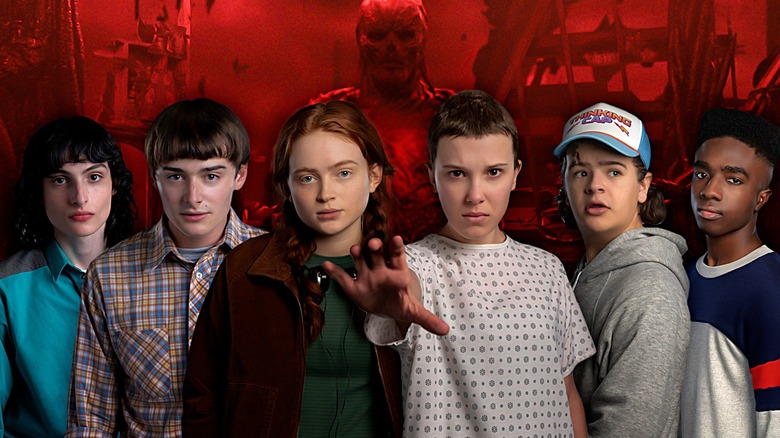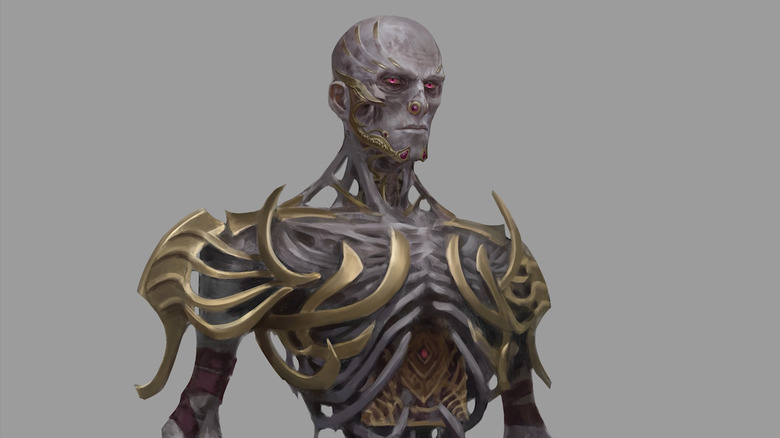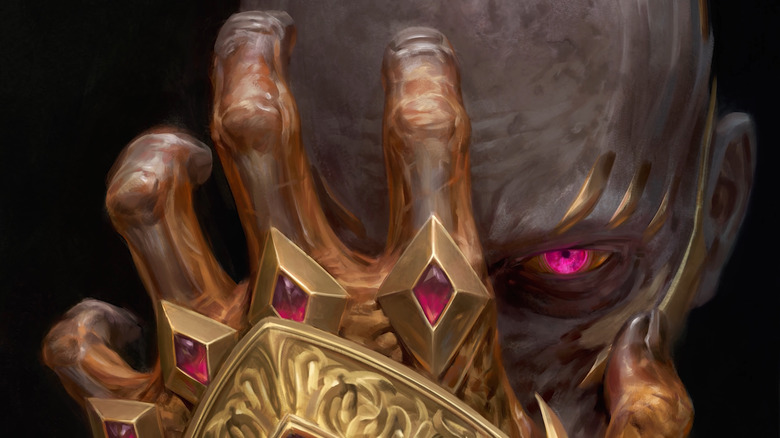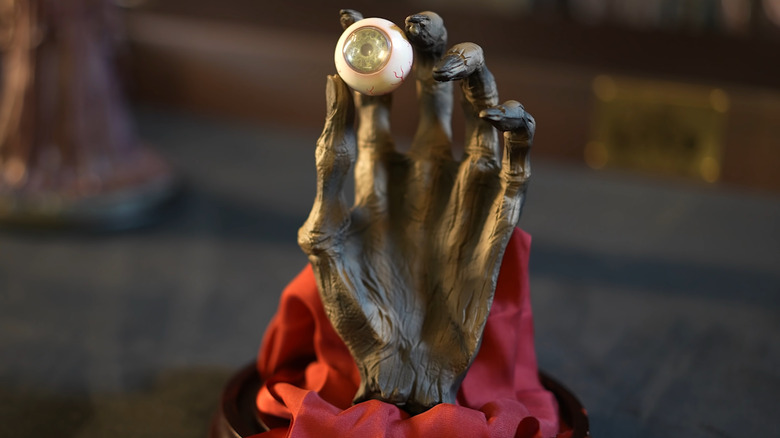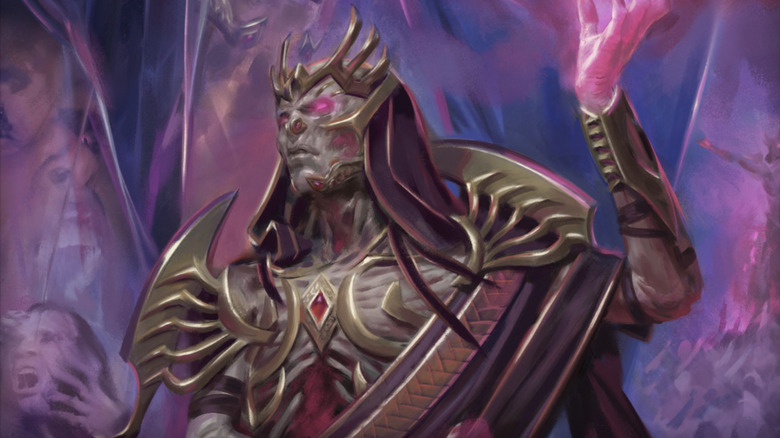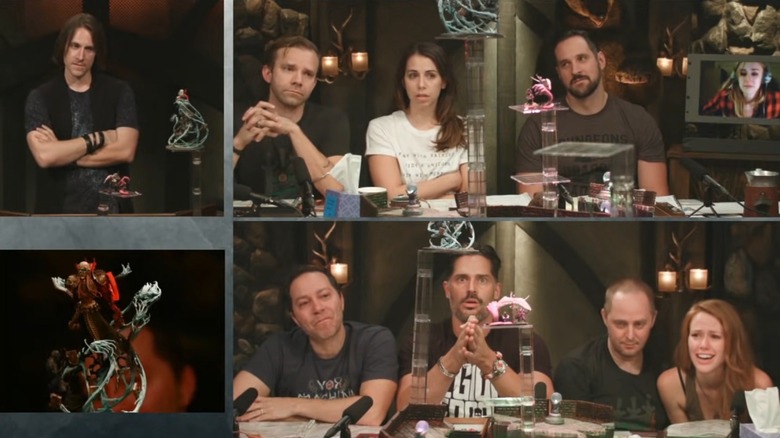D&D: 5 Facts About Vecna Stranger Things Fans Need To Know Right Now
"Stranger Things" Season 4 raises the stakes by introducing Henry Creel, aka Vecna (Jamie Campbell Bower). The villain puts a human, if deformed, face to the threat that the Upside Down has long posed the series' heroes, and his role helps the show answer some questions that viewers have been asking for years. That said, what some "Stranger Things" fans might not know is that Vecna, the moniker given to Henry by Dustin Henderson (Gaten Matarazzo) and Eddie Munson (Joseph Quinn), is the same as a "Dungeons & Dragons" villain.
Vecna isn't just any "D&D" antagonist, either. Over the years, he's emerged as a fan-favorite character, becoming one of the most famous foes in the history of "D&D." With that in mind, it makes sense that the "Stranger Things" creative team ultimately chose to name the show's greatest villain after Vecna.
The Vecna known among "D&D" fans is very different from the one featured on "Stranger Things." Still, both are uniquely powerful and ambitious foes who similarly seek to impose their will upon the worlds around them. Considering that, here are five "D&D" facts that "Stranger Things" fans should know about the Undying King himself.
He's an undead wizard
Most visual interpretations of Vecna have rendered him a gaunt, skeletal figure with decaying skin. That's because Vecna is considered, among other things, a "lich" in the "Dungeons & Dragons" canon, meaning he's a character who uses his magical capabilities to become undead. Vecna is now considered the first and greatest lich in "D&D" history. While Henry Creel isn't undead on "Stranger Things," the character doesn't look all that different from certain illustrations of Vecna.
While Vecna's origins have evolved over the years and largely remain mysterious, the character's official "D&D" backstory reveals that his fear of dying led him down the path of lichdom. His desire to beat the boundaries of common mortality and exist as a timeless entity is one of his defining traits, which is why he is such a constant figure in the world of "D&D." Whether he exists in a physical form or not, he's constantly trying to accrue more power and infamy, making him virtually impossible for anyone to defeat permanently.
That doesn't mean Vecna is unbeatable or impervious to physical injury. On the contrary, the character has been canonically vanquished several times. One of those instances sees him suffer a pair of injuries that have been a part of his backstory since he was introduced in 1976.
He was betrayed by his most trusted follower
While the lore surrounding Vecna has evolved over the years, the source of his original downfall has always remained the same. It's known among "Dungeons & Dragons" players that Vecna's initial run as a fear-mongering, power-hungry tyrant is cut short by none other than his lieutenant and right-hand man, Kas. At one point in his reign, it's said that Vecna crafted a weapon for Kas, known as "the Sword of Kas," that boosted the latter's power, making him more fearsome and ruthless in battle.
Unbeknownst to Vecna, his malice becomes a conscious element of the sword, and it slowly but surely persuades Kas to kill the evil lord and take his place. Just when it seems like Vecna is ready to complete his long-desired ascension to godhood, Kas engages his master in a battle, successfully cutting off Vecna's left hand and gouging out his left eye. However, Kas does not survive. The tower they fought on is destroyed, and all that's left in the wake of its destruction are the Sword of Kas and the Hand and Eye of Vecna.
His confrontation with Kas robs Vecna of his physical form for many years, but the survival of his left eye and hand guarantees that his influence throughout the "D&D" multiverse will continue to spread.
The Eye and Hand of Vecna are two powerful D&D artifacts
When he is mentioned for the first time in the 1976 "Dungeons & Dragons" supplementary rulebook, "Eldritch Wizardry," Vecna is just a name attached to two powerful magical artifacts: The Hand and Eye of Vecna. It is said the items are the sole physical remains of a defeated lich. It shouldn't be surprising to learn that they are considered extremely powerful "D&D" items.
Both grant powers to any player who acquires them. The Eye gives its wearer x-ray vision and the ability to cast spells through it. The Hand automatically increases the strength of a player's character and allows its wearer to cast powerful spells. Combined, the two artifacts provide additional abilities and even make their wearer immune to poison and disease.
They take a heavy toll, though. For starters, a character must gouge out their eye and cut off their hand to attune to the items. In case that isn't bad enough, using the Hand of Vecna to cast spells could force the wearer to commit an evil act of some kind, while the Eye's spell-casting abilities open the door for Vecna's spirit to devour its wielder's soul and take control of their body. If either item is removed from a character before death, they also immediately die.
His name is an anagram
For casual or new "Dungeons & Dragons" fans, it may be a surprise to learn that a character as powerful and legendary as Vecna is named after a popular fantasy and science fiction author. "Vecna" is an anagram of author Jack Vance's last name. While that may seem slightly random, it's worth noting that Vance played a major, if indirect, role in the creation of "D&D."
In particular, Vance's "Dying Earth" series partly inspired the original magic system of "D&D." His influence has been acknowledged repeatedly over the years, including by "Dungeons & Dragons" co-creator Gary Gygax, who once penned an essay titled "Jack Vance & The D&D Game." Notably, Vance is one of several fantasy authors whose work helped shape the rules and world of "D&D."
As former Wizards of the Coast designer David Noonan once wrote about the role-playing game, "The wellspring of fantasy literature inspired a lot of our rules, too. The 'Dying Earth' books from Jack Vance had some influence on how 'D&D' spellcasting works, although it's not so easy to see the connection today."
All of this is to say that, while this might seem like little more than an obscure piece of trivia, it only further proves why many fans consider Vecna a core "D&D" character. Not only was he created early in the game's history, but his name is an indirect reference to one of the authors who inspired and influenced the role-playing game. You can't say both those things about many other "D&D" villains or characters.
He is the final villain of Critical Role Campaign 1
"Stranger Things" isn't the only "Dungeons & Dragons"-related show that has used Vecna in its own way. The first campaign of the popular actual play series "Critical Role" also puts the Undying King at the center of its final, world-ending conflict. Through the aid and actions of his followers, Vecna can achieve a physical form again in the campaign's second half, and he promptly resumes his attempts to ascend to godhood. Much to the horror of the world's other gods and Vox Machina, the central adventuring party of "Critical Role" Campaign 1, he accomplishes his goals.
Vecna's ascension sets the stage for the campaign's climax, which sees Vox Machina go toe-to-toe with the villain in an attempt to weaken his toxic grasp on the world by banishing him forever from the Prime Material Plane. Thankfully, while victory certainly doesn't come easy, Vox Machina defeats Vecna in the second-to-last episode of "Critical Role" Campaign 1.
Amazon Prime Video's "The Legend of Vox Machina" is an animated adaptation of the first "Critical Role" campaign. While Vecna does not appear in the show's first two seasons, he is teased throughout, referred to as "The Whispered One." Thanks to these shows, more viewers are becoming aware of who Vecna is, which likely comes as music to the ears of the iconic "D&D" villain.
